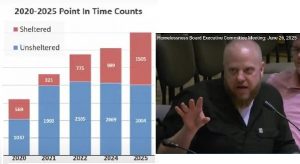What-if scenarios help envision transition to sustainable future
3 min read
A status report of progress since last summer’s New Era Convergence. On June 24:
Alberta Pedroja: The impetus came about from the Ad Hoc Prout Group.
A number of us working on this project have been in emergency management, in our professional life. We know that there are five phases in the world of the thinking of emergency management: prevention, preparation, response, recovery, mitigation. So, recovery was defined as ‘returning to normal operations.’ We’re actually meeting with the people in emergency management who may or may not really think that we need a transition, but they know that recovery has to be rethought and actually there’s much being done to rethink this whole idea.
[00:00:50] So this project is actually trying to work through having communities come together so that recovery can go more smoothly. And then of course, transition is part of it because we want communities to be able to identify: What kind of community do we want to live in?
[00:01:08] So, the Community Driven Recovery and Transition project uses disaster scenario planning to gather a team to build a plan that leads to a resilient, just and sustainable future.
[00:01:21] We think that if we were to come up with a disaster scenario, we would then be able to bring people together on an as-if basis. How do you get good at something? You practice it. So that’s what the idea is that we’re going to practice what we would be doing in the event of a scenario.
[00:01:42] The New Era Convergence identified a set of values, and that’s the values that we want in our transition: resilient, just and sustainable. By working in sector teams, such as food, housing, well-being, government, and the economy, plans are created that embody the New Era values: regeneration, cooperation, equity, inclusion and decentralization. We had people that we could anchor those sectors.
[00:02:11] So the scenario that we picked is defined as an actual scenario. It has been predicted that we can expect a 200-year flood in California, with 16 million people displaced and $1 trillion in damages. The result will be a 240-mile lake, rendering portions of the state uninhabitable. Combined with the shift in annual rainfall, this will cause many to find housing in other parts of the country.
[00:02:38] In this scenario, Lane County has acquired an additional 10,000 men, women, and children. We are looking for a near-term solution for housing resettlement into our community that is moving towards a sustainable, cooperative, equitable resettlement.
[00:02:53] John Q: Facilitators from each of the sector teams gave an overview of their work, and welcomed others to join them in Community Driven Recovery and Transition. To learn more, sign up at NewEraConvergence.org.
The Community-Driven Recovery and Transition project uses disaster scenario planning to gather a team to build a community response that leads to a resilient, just, and sustainable future. By working in sectors teams such as food, housing, wellbeing, governance, and the economy, plans are created that embody the values of regeneration, cooperation, equity, inclusion and decentralization. Over the course of the project, the sector teams come together to integrate and cross check the plans to build a unified plan for recovery and transition. For more information, contact Alberta Pedroja.




